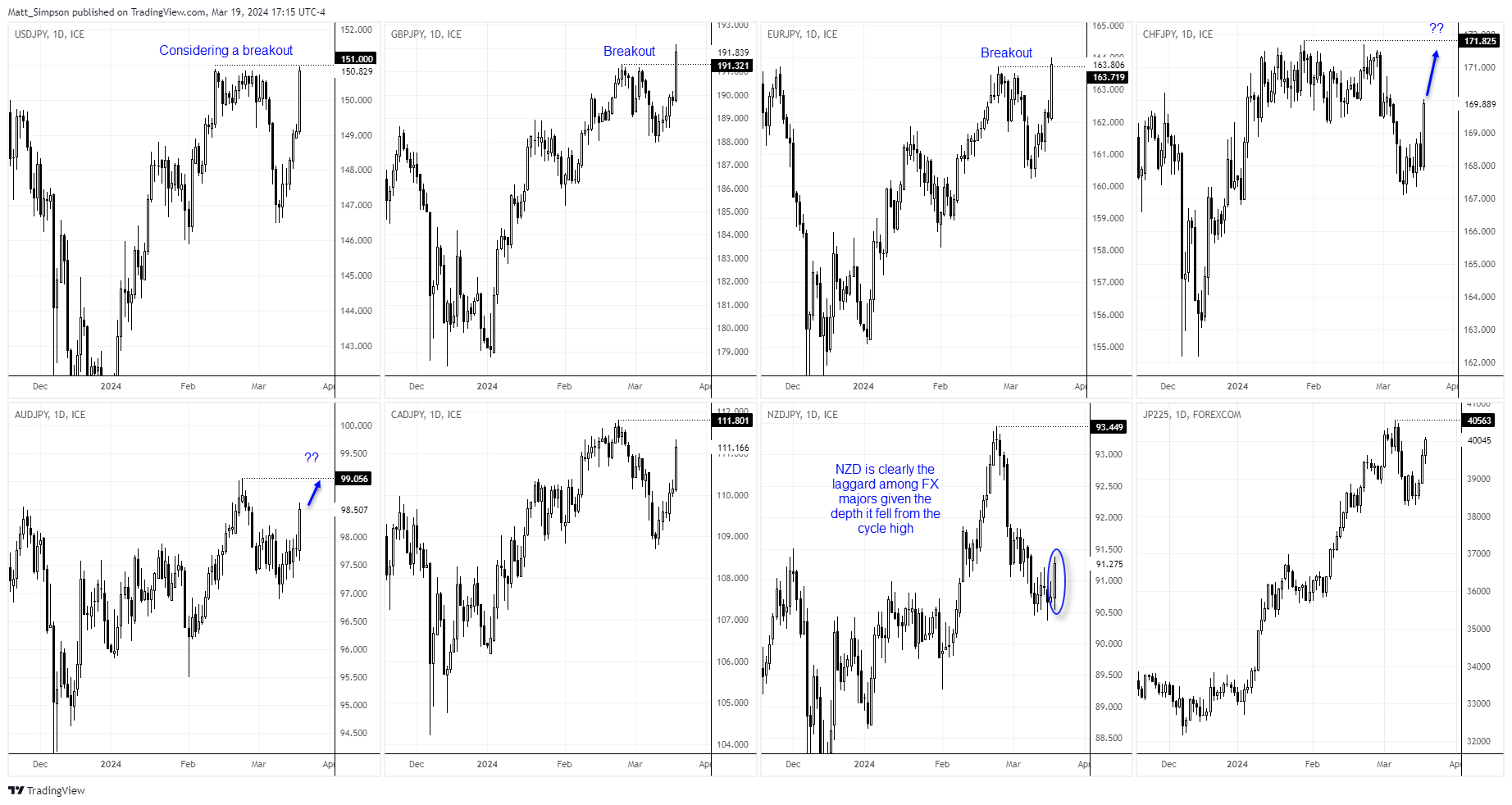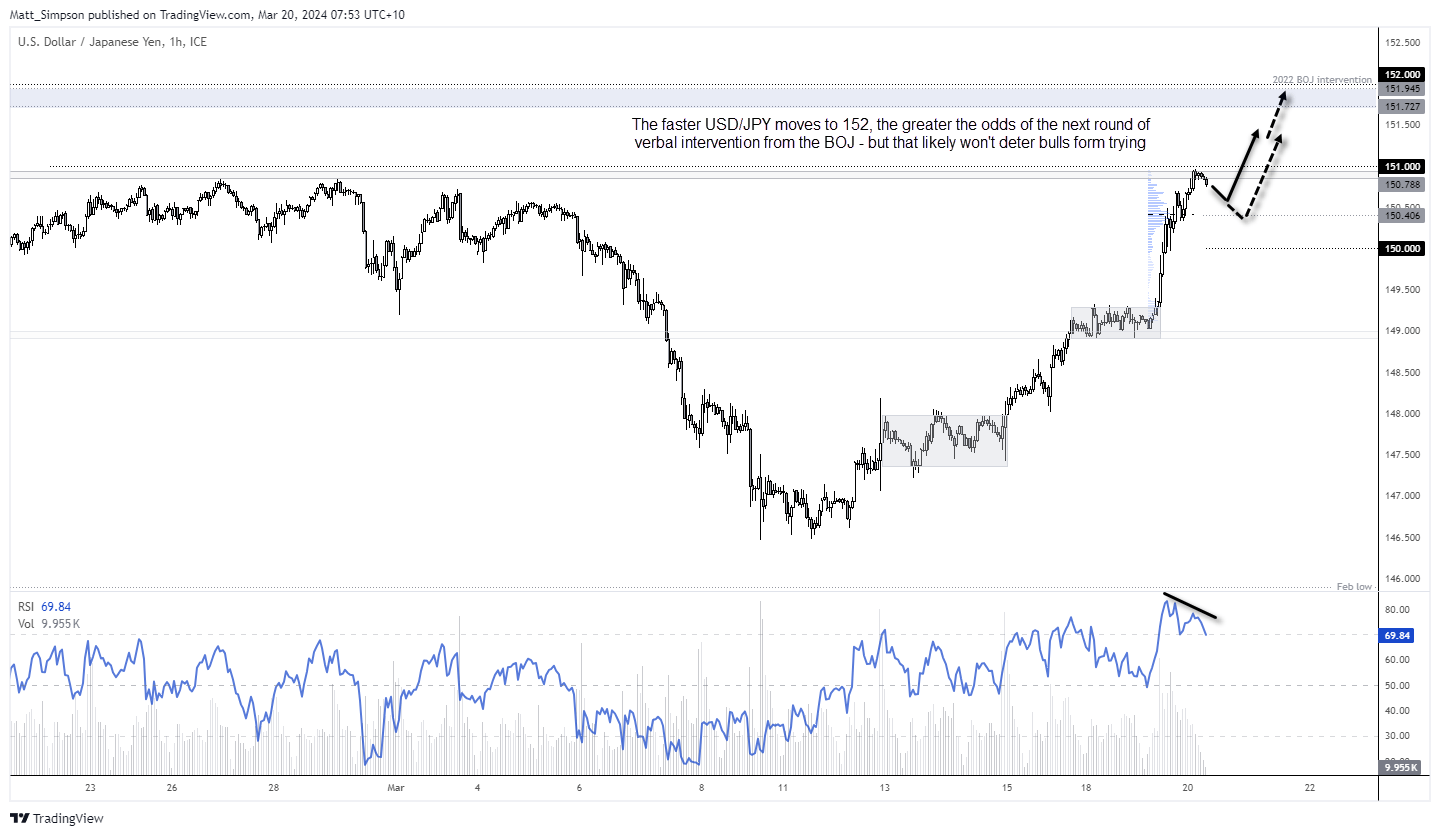
Market Summary:
- The Bank of Japan finally ditched negative rates after eight years to take their interest rate form -0.1% to 0% and abandoned YCC control, yet ETF purchases are set to continue until further notice
- The fact that the Japanese yen was broadly weaker shows not only was this already priced in, but that markets expected more from the BOJ in terms of tightening
- USD/JPY was the leader among yen pairs, rising nearly 1.2% during its best day in six weeks and second best since early November, closing just beneath the 151 handle
- GBP/JPY above its YTD high to reach its most bullish level in seven months, and whilst EUR/JPY saw an intraday break to new highs it puled back ahead of the NY close
- The weaker yen helped the Nikkei 225 extend its rally for a third day and close marginally above 40k
- The BOJ’s next 10bp hike has been fully priced in for October according to Bloomberg, with no real conviction of a hike much sooner Canada’s inflation data undershot expectations once again, bolstering bets of a BOC easing, with Bloomberg fully pricing in a 25bp cut in July
- USD/CAD initially taped a new YTD high earlier in the session but the stronger US dollar saw the pair reverse to close the day with a shooting star candle
- The RBA held interest rates at 4.35% and removed their slight hawkish bias, which excited traders enough to begin repricing cuts, sending AUD/USD t just shy of my 65c target to a 9-day low
- Gold continues to hold above its previous record high and trades within a tight range, which can be indicative of incoming volatility (with the trigger likely to be the FOMC meeting)
You can get a good feel of relative strength among FX majors by looking at how they performed against the weaker Japanese yen on Tuesday. GBP and EUR are clear leaders, having broken above cycle highs although USD/JPY was the strongest performer on the day. Despite it bullish outside day, NZD is clearly a laggard given how much it has fallen from its February highs compared to its FX major peers.

Of course, this brings us to an important question. Will the BOJ or MOF now become vocal about a weaker currency, as they have in the past? Whilst they remain adamant they do not fight a weaker yen, they do not like their currency to fall too quickly. And the rate at which the Japanese yen declined across the board yesterday is surely to raise a few eyebrows among officials, given the levels then yen is now trading at and the speed it got there. And this could lead to verbal intervention from BOJ or MOF officials if the currently level of volatility and direction persists.
Events in focus (AEDT):
- 12:15 – China PBOC 1 and 5-year loan prime rates
- 13:00 – Inflation expectations (Melbourne Institute)
- 18:00 – UK CPI
- 21:00 – China Foreign direct investment
- 05:00 – FOMC interest rate decision, statement, updated staff forecasts
- 05:30 – Jerome Powel press conference
USD/JPY technical analysis:
The rise of USD/JPY picked up speed after finding support around 149, then proceeded to tap the 1-day and 1-week implied volatility levels after the BOJ hiked their interest rate. But the fact it has paused below 149 and around the initial 1-week implied volatility level to me suggests it may need to retrace. And we’re already seeing early sighs of that in today’s Asian session.
RSI (14) has formed a bearish divergence in the overbought zone and momentum is turning lower from the 151 handle. Given the bias for a less-dovish / more-hawkish than expected Fed meeting, the bias is for a break above 151 – even though this risk verbal intervention from the BOJ and MOF the closer it gets to 152. Ultimately the bias is for a small retracement today in Asia, and doubt we’ll see prices break beneath the 150.40/50 Zone.

View the full economic calendar
-- Written by Matt Simpson
Follow Matt on Twitter @cLeverEdge
How to trade with City Index
You can trade with City Index by following these four easy steps:
-
Open an account, or log in if you’re already a customer
• Open an account in the UK
• Open an account in Australia
• Open an account in Singapore
- Search for the market you want to trade in our award-winning platform
- Choose your position and size, and your stop and limit levels
- Place the trade






